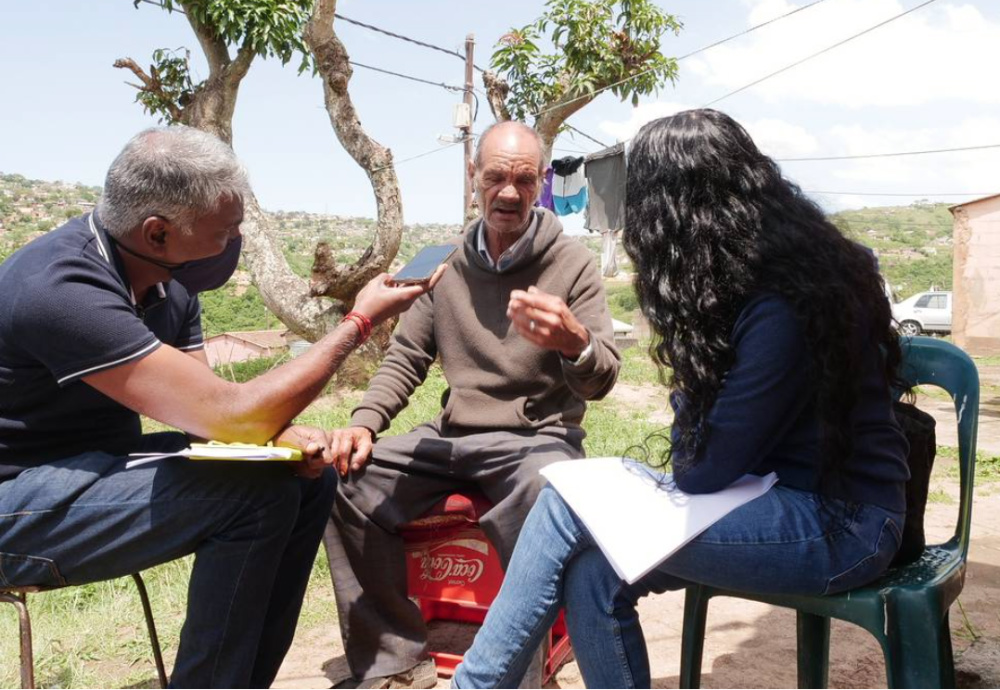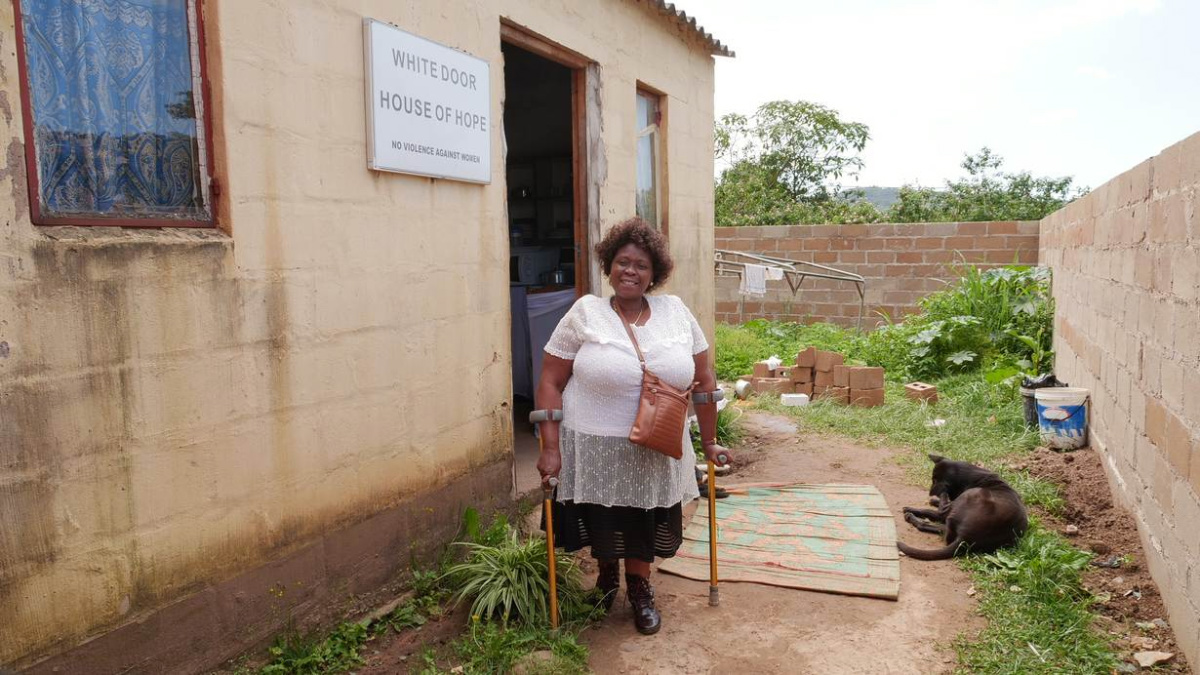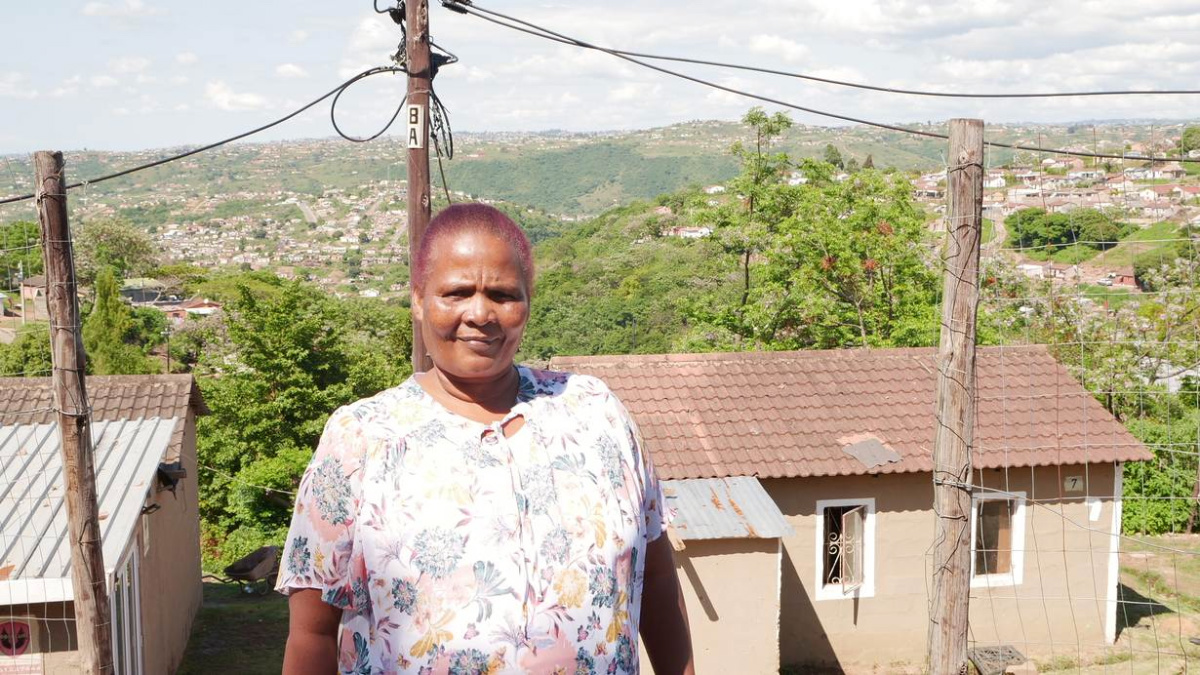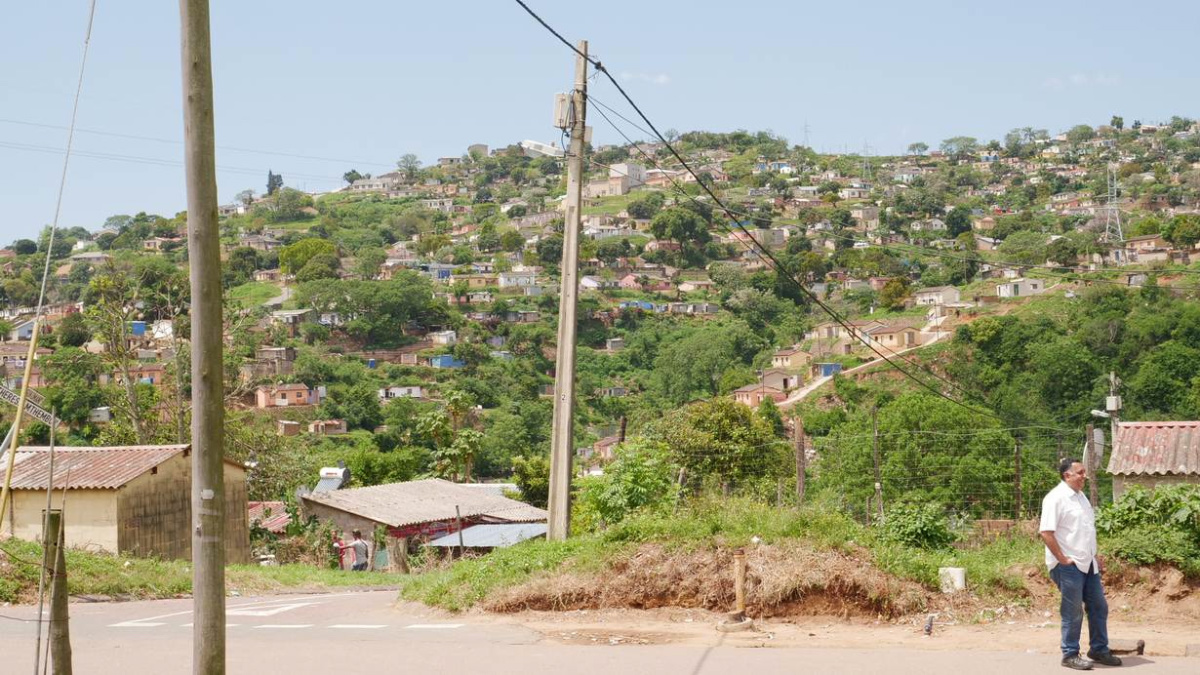
KIM HARRISBERG, of Thomson Reuters Foundation, reports from Welbedacht, a community researchers say it could be a model for other places still scarred by apartheid…
Welbedacht, South Africa
Thomson Reuters Foundation
The people of Welbedacht in South Africa always knew there was something special about their neighbourhood.
In contrast to the towering walls and electric fences seen in more crime-ridden urban areas, residents criss-cross between open and interconnected land on undulating green hills and say crime is less frequent.

Researcher Sogrendren Moodley (left) and Monique Marks (right) interview Welbedacht resident Victoria Barker in KwaZulu-Natal, South Africa, on 26th October. PICTURE: Thomson Reuters Foundation/Kim Harrisberg.
Eager to identify the key to Welbedacht’s harmony, researchers think they have discovered one of the answers – its long-standing ethnic diversity, a finding they hope could serve as a model for areas still scarred by apartheid segregation.
“This place can be a good example to the rest of the world; we live like a family,” said Mavis Nkosi, a 60-year-old resident of Welbedacht, whose people are mainly Black Africans and Indians, with a white and mixed race minority.
“This place can be a good example to the rest of the world; we live like a family.”
– Mavis Nkosi, a 60-year-old resident of Welbedacht.
South Africa is the world’s most unequal country as of 2022, according to the World Bank, following decades of racially segregated, white minority rule, high-level corruption and rising unemployment.
Many of Welbedacht’s some 7,000 households relocated here in 2004 due to slum resettlement, and the closing of a homeless shelter in the same year that housed racially diverse individuals.
Those events saw families relocated to the city’s periphery, gaining houses but often facing challenges with electricity and sanitation access.
But despite such hardships, the neighbourhood has long been seen as a beacon for social cohesion, say urban researchers.
“We share battles,” said Nkosi, who runs an organisation helping to train people with disabilities.

Mavis Nkosi, a community activist, poses for a photo in front of a shelter she helps run for abused women in Welbedacht, South Africa, on 26th October, 2021. PICTURE: Thomson Reuters Foundation/Kim Harrisberg
This drove researchers at the Durban University of Technology to document residents’ stories through oral testimonies to understand why, in a crime-plagued, unequal country, Welbedacht’s sense of community is so strong.
“The biggest lesson we take from Welbedacht is that diversity is a resource,” said Linda Mbonambi, a manager at the local eThekwini municipality, during a community celebration to honour the research last month.
The sounds of tambourines, drums and prayers spilled out from the neighbourhood ashram, where dozens had gathered to recognise the community as a model of racial and social unity.
“We want to take this research further, scale it up, and keep learning directly from other communities too,” Mbonambi told the Thomson Reuters Foundation as he walked between mounted photographs and testimonies of DUT’s Welbedacht interviewees.
Around the world, studies have reached varying conclusions about the links between racial diversity and social cohesion, but the Durban study is not the first to highlight it as a potentially positive factor in stemming crime.
Close ties between neighbours and opportunities to mix could be another factor – something facilitated by the lack of walls.
“Not having physical walls allows for the flow of people, resources and ideas,” said Monique Marks, a sociology lecturer at DUT, and head of the university’s Urban Futures Centre.
It also allows for greater natural surveillance – visibility that aids crime reduction, added Sogendren Moodley, a research associate at DUT also leading the research.

Vasi Pillay, a local pastor and community leader from Welbedacht, poses for a photo in front of her home turned into a church in KwaZulu-Natal, South Africa, on 26th October, 2021. PICTURE: Thomson Reuters Foundation/Kim Harrisberg
Church leader and local resident Vasi Pillay, said that during apartheid the Indian indentured labourers and Black South Africans would watch Diwali fireworks together, and help hide one another when police raided the area to enforce segregation.
“We built solidarity here,” she said, seated in her church built onto a small government-supplied house as her children – many of them adopted – served cool drinks and food.
Pillay and other female leaders like Nkosi say this sense of solidarity has lasted, with mothers always keeping an eye on one another’s children, sharing meals and sheltering abused women.
A local economy that is mainly informal – most residents say they have no title deeds to their government-allocated homes, but also no landlords – has allowed residents to take ownership of their own needs, the DUT researchers found.
Unable to sell their homes and move on, residents focus on home improvements instead, adding bathrooms, extra rooms or new levels.
We rely on our readers to fund Sight's work - become a financial supporter today!
For more information, head to our Subscriber's page.
Together with religious leaders, they have pooled resources to turn churches and temples into community centres, run female-led shelters for abused women and abandoned children, and provide skills training to tackle poverty and inequality.
“Yes, infrastructure is important, but this community teaches us that putting people at the centre of development is essential,” said Mbonambi.
Resident Tholi Jacobs said she saw a group of women heading to work in the morning, so she asked them for advice on finding a job.
Soon they had helped her find a job as a domestic worker and, in exchange, she taught them how to grow vegetables.
“When we help ourselves, we help each other, no matter what race we are,” said Nkosi, as she worked on her vegetable patch.

Following South Africa’s first democratic election in 1994, the late Archbishop Desmond Tutu described post-apartheid South Africa as the “Rainbow Nation” to reflect the different races and ethnicities coming together.
It is a term that has since been criticised by activists and academics who feel it has romanticised diversity without criticising what needs to be changed.
Since the dawn of democracy, the national government has rolled out housing programmes, welfare grants and more recently, COVID-19 relief grants to tackle inequality, although critics say corruption has hindered their reach.
Officials say there are other community upliftment projects being implemented across the country – from community gyms, to creches and food gardens – that do not get enough public attention.
Although Welbedacht is worth celebrating, there may be other variables to consider as to why community members report strong feelings of safety and solidarity, said Billal Haq, an urban designer at eThekwini municipality.
“The small size of Welbedacht is an important factor to consider as to why the looting did not hit them in July, rioters may simply have targeted places with bigger town centres,” said Haq, referring to unrest that hit the country last year.
Size aside, residents of Welbedacht think the Rainbow Nation ideology is alive and well where they live and has spurred local government to invest in plans for parks to be built as well as future social research in the community.
“We serve everybody, no matter what their culture is,” said Vincent Govender, whose parents helped run one of the first Hindu temples in Welbedacht.
“We live as a rainbow nation.”






